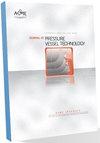包括非线性效应在内的RPV内部地震荷载的确定性和概率评估
IF 1
4区 工程技术
Q4 ENGINEERING, MECHANICAL
Journal of Pressure Vessel Technology-Transactions of the Asme
Pub Date : 2022-02-04
DOI:10.1115/1.4053753
引用次数: 0
摘要
本文介绍了控制棒驱动机构(CRDM)和选定反应堆压力容器(RPV)内部构件(即堆芯筒(CB)上法兰和上堆芯板对中)的动态分析结果,以及由此产生的应力。带有CESHOCK的RPV堆内构件的动力学分析模型由弹簧和集中质量以及梁单元组成。该模型考虑了RPV内部的材料非线性、滑动、摩擦和间隙/冲击效应。接触区域的精细有限元建模用于校准动态模型中使用的力-位移关系。给出了确定性分析和概率分析。激励基于上游时程(TH)分析和核蒸汽供应系统(NSSS)和反应堆厂房的耦合模型。考虑了地面运动参数(剪切模量和阻尼)和建筑参数(杨氏模量和阻尼器)的可变性。确定性分析证实,在地震激励的情况下,堆芯吊篮上法兰是RPV堆内构件受力最大的部分。概率分析表明,堆芯筒基频下的谱加速度与堆芯筒法兰上的最大载荷之间存在稳健的相关性。这与核工业脆性分析采用的标准假设之一一致,并在本分析中对堆芯筒法兰进行了确认。本文章由计算机程序翻译,如有差异,请以英文原文为准。
Deterministic and Probabilistic Evaluation of Seismic Loads on RPV Internals including Nonlinear Effects
The paper presents analytical results for the dynamic analysis of the control rod drive mechanisms (CRDM) and selected Reactor Pressure Vessel (RPV) internals, i.e. core barrel (CB) upper flange and upper core plate centering, as well as resulting stresses. The model for the dynamic analysis of the RPV Internals with CESHOCK consists of springs and lumped masses, combined with beam elements.
The model is taking into account material nonlinearities, sliding, friction and gap/impact effects inside the RPV. Refined finite element modelling of contact regions is used to calibrate the force-displacement relationship used in the dynamic model.
Both deterministic and probabilistic analyses are presented. The excitations are based on upstream time history (TH) analyses with a coupled model of the nuclear steam supply system (NSSS) and the reactor building. Variability of ground motion parameters (shear modulus and damping) and building parameters (Young's modulus and damping) is taken into account.
The deterministic analyses confirm that the core barrel upper flange is the most highly stressed part of the RPV internals in case of seismic excitations.
The probabilistic analyses show that there is a robust correlation between the spectral acceleration at the fundamental frequency of the core barrel and the maximum load on the core barrel flange. This is in agreement with one of the standard assumptions adopted for fragility analysis in the nuclear industry and is confirmed for the core barrel flange in the present analysis.
求助全文
通过发布文献求助,成功后即可免费获取论文全文。
去求助
来源期刊
CiteScore
2.10
自引率
10.00%
发文量
77
审稿时长
4.2 months
期刊介绍:
The Journal of Pressure Vessel Technology is the premier publication for the highest-quality research and interpretive reports on the design, analysis, materials, fabrication, construction, inspection, operation, and failure prevention of pressure vessels, piping, pipelines, power and heating boilers, heat exchangers, reaction vessels, pumps, valves, and other pressure and temperature-bearing components, as well as the nondestructive evaluation of critical components in mechanical engineering applications. Not only does the Journal cover all topics dealing with the design and analysis of pressure vessels, piping, and components, but it also contains discussions of their related codes and standards.
Applicable pressure technology areas of interest include: Dynamic and seismic analysis; Equipment qualification; Fabrication; Welding processes and integrity; Operation of vessels and piping; Fatigue and fracture prediction; Finite and boundary element methods; Fluid-structure interaction; High pressure engineering; Elevated temperature analysis and design; Inelastic analysis; Life extension; Lifeline earthquake engineering; PVP materials and their property databases; NDE; safety and reliability; Verification and qualification of software.

 求助内容:
求助内容: 应助结果提醒方式:
应助结果提醒方式:


